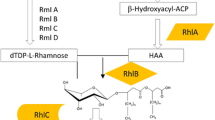Abstract
Pseudomonas aeruginosa produces the biosurfactant rhamnolipid, which has several potential biotechnological applications. The synthesis of this surfactant is catalyzed by rhamnosyltransferase 1, composed of the proteins RhlA and RhlB. Here we report that RhlA plays a role not only in surfactant synthesis, but also in the production of polyhydroxyalkanoates, polymers that can be used for the synthesis of biodegradable plastics.

Similar content being viewed by others
References
Burger MM, Glaser L, Burton RM (1963) The enzymatic synthesis of rhamnose-containing glycolipids by extracts of Pseudomonas aeruginosa. J Biol Chem 238:2595–2602
Campos-García J, Caro AD, Nájera R, Miller-Maier RM, Al-Tahhan RA, Soberón-Chávez G (1998) The Pseudomonas aeruginosa rhlG gene encodes a NADPH-dependent b-ketoacyl reductase which is specifically involved in rhamnolipid synthesis. J Bacteriol 180:4442–4451
Chandrasekaran EV, Bemiller JN (1980) Constituent analyses of glycosaminoglycans. Methods Carbohydr Chem 8:89–96
Costerton JW (1980) Pseudomonas aeruginosa in nature and disease. In: Sabath CD (ed) Pseudomonas aeruginosa: the organism, diseases it causes and their treatment. Hans Huber, Bern, pp 15–24
Deziel EF, Lepine F, Milot S, Villemur R (2003) rhlA is required for the production of a novel biosurfactant promoting swarming motility in Pseudomonas aeruginosa 3(3-hydroxyalkanoic acids (HAAs) the precursors of rhamnolipids. Microbiology 149:2005–2013
Hancock REW, Carey AM (1979) Outer membrane of Pseudomonas aeruginosa: heat-and 2-mercaptoethanol-modifiable proteins. J Bacteriol 140:902–910
Lang S, Wullbrandt D (1999) Rhamnose lipids-biosynthesis, microbial production and application potential. Appl Microbiol Biotechnol 51:22–32
Madison II, Huisman GW (1999) Metabolic engineering of poly(3-hydroxyalkanoates) from DNA to plastics. Microbiol Mol Biol Rev 63:21–53
Maier MR, Soberón-Chávez G (2000) Pseudomonas aeruginosa rhamnolipids: biosynthesis and potential applications. Appl Microbiol Biotechnol 54:625–633
Ochsner UA, Fiechter A Reiser J (1994) Isolation, characterization, and expression in Escherichia coli of the Pseudomonas aeruginosa rhlAB genes encoding a rhamnosyltransferase involved in rhamnolipid biosurfactant synthesis. J Biol Chem 269:19787–19795
Ochsner UA, Reiser J, Fietcher A, Witholt B (1995) Production of Pseudomonas aeruginosa rhamnolipid biosurfactants in heterologous host. Appl Environ Microbiol 61:3503–3506
Olivera ER, Cenicero D, Jodra R, Minambres B, García B, Abraham GA, Gallardo A, San Román J, García JL, Naharro G, Luengo JM (2001) Genetically engineered Pseudomonas: a factory of new bioplastics with broad applications. Environ Microbiol 3:612–618
Rahim R, Ochsner UA, Olvera C, Graninger M, Messner P, Lam JS, Soberón-Chávez G (2001) Cloning and functional characterization of the Pseudomonas aeruginosa rhlC gene that encodes rhamnosyltransferase 2, an enzyme responsible for di-rhamnolipid biosynthesis. Mol Microbiol 40:708–718
Rehm BHA, Kruger N, Steinbuchel A (1998) A new metabolic link between fatty acid de novo synthesis and other proteins required for PHA synthesis. J Biol Chem 273:24044–24051
Rehm BHA, Mitsky TA, Steibuchel A (2001) Role of fatty acid de novo biosynthesis in polyhydroxyalkanoic acid (PHA and rhamnolipid synthesis by Pseudomonads: Establishment of the transacylase (PhaG)-mediated pathway for PHA biosynthesis in Escherichia coli. Appl Environ Microbiol 67:3102–3109
Smith RS, Iglewski BH (2003) P. aeruginosa quorum-sensing systems and virulence. Curr Opin Microbiol 6:56–60
Timm A, Steinbüchel A (1990) Formation of polyesters consisting of medium-chain-length 3-hydroxyalkanoates acids from gluconate by Pseudomonas aeruginosa and other fluorescent Pseudomonads. Appl Environ Microbiol 56:3360–3367
Timm A, Steinbüchel A (1992) Cloning and molecular analysis of the poly(3-hydroxyalkanoates acid) gene locus of Pseudomonas aeruginosa PAO1. Eur J Biochem 209:15–30
Van Delden C, Iglewski BH (1998) Cell-to cell signaling and Pseudomonas aeruginosa infections. Emerg Infect Dis 4:551–560
Zhang Y, Miller M (1992) Enhancement of octadecane dispersion and biodegradation by a Pseudomonas rhamnolipid surfactant (biosurfactant). Appl Environ Microbiol 58:3276–3282
Acknowledgement
This research was founded in part by the Universidad Nacional Autónoma de México through grant DGAPA PAPIIT IIX201404.
Author information
Authors and Affiliations
Corresponding author
Rights and permissions
About this article
Cite this article
Soberón-Chávez, G., Aguirre-Ramírez, M. & Sánchez, R. The Pseudomonas aeruginosa RhlA enzyme is involved in rhamnolipid and polyhydroxyalkanoate production. J IND MICROBIOL BIOTECHNOL 32, 675–677 (2005). https://doi.org/10.1007/s10295-005-0243-0
Received:
Accepted:
Published:
Issue Date:
DOI: https://doi.org/10.1007/s10295-005-0243-0




